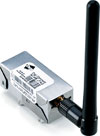
Increasingly, industrial and machine control is implemented using Ethernet-based networks, with all devices in the network connected by either twisted pair cable for 10/100 Ethernet connections, or wireless networks, using 802.11-based devices. A variety of industrial protocols have been developed that operate over Ethernet networks, and supplant earlier serial-based industrial networking protocols, such as CAN and Modbus.

Ethernet-based solutions provide many intrinsic advantages over the older networks, mainly in the areas of speed, scalability and flexibility. Ethernet networks offer faster transmission times, and the ability to spread that network over a wider area. In addition, more devices can be connected to an Ethernet network without degrading the transmission performance of the network
Finally, Ethernet-based networks are much more flexible, as they can take advantage of the existing networks in a facility. Wired Ethernet networks provide a long connection range between devices, while wireless Ethernet connections require no cabling at all, so installation and rearranging of equipment is much easier - little network reconfiguration will be required.
Protocols
Even in wireless networking, there are different protocols to choose from, each with their own unique benefits. The 802.11b is the most common and widely deployed type of wireless at the moment. 802.11g, more recently defined, offers faster speeds at slightly higher prices. 802.11 b and g both operate in the 2,4 GHz spectrum, and this can cause problems, because many other devices operate in the same frequency - microwave ovens, cordless phones and other networking devices like ZigBee or RF radios. In facilities where there is too much interference at 2,4 GHz, the 802.11a protocol is available, operating in the less-crowded 5 GHz spectrum. This is suited to specialised applications, where a large number of devices need to be deployed.
As an embedded developer, there is increasing pressure to include features in your product that allow it to communicate with other devices over an Industrial Ethernet network. This requires not only including Ethernet connectivity in your device, but also support in your embedded software for the various Ethernet protocols that are required to implement machine-to-machine communication in your particular vertical market. In many situations, simple TCP/IP support is no longer enough.
A very common Industrial Ethernet protocol in use today is Profinet. Evolving out of the Fieldbus-based Profibus, Profinet is designed to run on standard 10/100 Ethernet networks. Profinet is a very common requirement in devices and sensors used in process control applications. It comes in different levels of performance requirements, from the Profinet/RT for realtime applications, to the Profinet/IO and Profinet/CB for less demanding applications. Profinet is designed to be an open standard for industrial automation of Ethernet, and it was adopted as the standard protocol for Industrial Ethernet by German automotive manufacturers in late 2004.
While Profinet/RT performance requires specialised processors such as the Siemens Ertec processor, Digi has implemented Profinet/IO in its ARM-based products by providing a stack bypass API in its NET+OS realtime operating system. This unique API is designed to bypass the standard TCP/IP stack for Ethernet communications, providing a very fast, deterministic response that allows devices to achieve peak ProfinetI/O performance.
The NET+OS RTOS can run on any of Digi International's embedded devices, including the NET+ARM NS9360 processor (Figure 1) or the Digi Connect ME and Connect Wi-ME modules (Figure 2). These are networking co-processor modules that are designed to replace an RJ45, but include a complete networking subsystem, ready to be integrated into an embedded product. This module (Figure 1) includes an ARM7 processor and memory, as well as an embedded RTOS that provides complete Ethernet connectivity, with a TCP/IP stack and a web server.


Connect modules can communicate with the main embedded channel via a serial channel, providing an easy way to pass data or machine status out over the network or to display it at the device so it can be viewed easily via a web browser. The Digi Connect ME supports 802.11b wireless networking.
Digi Connect Modules are ideal for adding Industrial Ethernet capabilities to products that need to communicate with other devices. For more sophisticated applications, including LCD and touch screens to operate machines or display data, the Digi ConnectCore Wi-9C (Figure 3) includes additional performance and features such as USB support and integrated LCD controller. The modules also support both 10/100 wired and 802.11b/g wireless networking.

Other Industrial Ethernet protocols in use today include Modbus/TCP and Ethernet/IP. Modbus/TCP is an extension into Ethernet of a fieldbus introduced by Modicon in 1979, while Ethernet/IP is developed and supported by Rockwell Automation. Ethernet/IP is commonly found in process control or material handling applications, and is implemented using standard Ethernet devices and cabling.
The Modbus protocol first published back in the 1970s, is in wide use by industrial automation companies. No changes have been made to the protocol: Modbus/TCP embeds a Modbus frame into a TCP frame.
The Protocessor module (www.protocessor.com) from FieldServer Technologies provides support for these protocols, and many others, on Digi's software and hardware. This company offers software to run on Digi's modules as well as products based on Digi hardware that already include support for the required Industrial Ethernet protocol.
The extensible nature of Digi's embedded networking products have allowed companies like FieldServer to provide applications running on Digi's NET+OS operating system to support a variety of Industrial Ethernet protocols.
The integrated approach provided by Digi and its partners makes it easy for an embedded developer to quickly implement Industrial Ethernet protocol support on the products. Digi's NET+OS and the Connect ME, Connect Wi-ME and the ConnectCore 9C are all supported by Digi's new Jump Start Kits, making it easy to get started in developing applications with these modules as well as exploring the implementation of Industrial Ethernet protocols.

© Technews Publishing (Pty) Ltd | All Rights Reserved